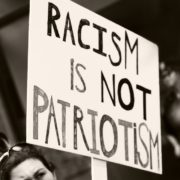PRESIDENT Donald Trump on Sunday, July 14 tweeted that four congresswomen of color should “go back and help fix the totally broken and crime infested places from which they came” before criticizing the way the country is currently being run.
He followed up his tweet thread by accusing members of Congress who are unhappy with the way the country is being run of hating America and said they are “free to leave.”
Three of the four female Democrats to which the president was referring — Reps. Alexandria Ocasio-Cortez of New York, Rashida Tlaib of Michigan and Ayanna Pressley of Massachusetts — were born in the United States, and Rep. Ilhan Omar of Minnesota was born in Somalia.
In response to Trump’s tweets, Ocasio-Cortez at a press conference said, “We don’t leave things that we love, and when we love this country, what that means is that we propose solutions to fix it.”
She added that the president “does not know how to defend his policies, so what he does is attack us personally, and that is what this is all about.”
What followed was a days-long sociopolitical debate on racism which was brought to a head on Wednesday, July 17 when Trump supporters at a rally for chanted “send her back!” when Trump mentioned the four congresswomen in a speech.
The message of “go back to your country” and its many derivatives — which directed to certain immigrants as well as people of color regardless of their citizenship — has resurfaced throughout American history.
Alan Kraut, a history professor at American University, told PBS this week that while Trump singling out the four congresswomen for their race was “ugly,” it isn’t anything new.
Kraut said that the ideology behind the “go back to your country” remark is “one of the greatest paradoxes of American society. On the one hand we pride ourselves as being a nation of nations. And we glorify that and celebrate that in a variety of ways. And at the same time, this is the society that has passed the Chinese Exclusion Law.”
The Chinese Exclusion Law, which Kraut referenced, was legislation passed in 1882 that banned Chinese laborers from emigrating to the U.S. This was a response to the perceived threat of the Chinese taking away employment from white laborers. The Chinese Exclusion Law was the first piece of legislation banning immigration from a specific ethnic group.
Almost a half-century later, the U.S. passed the Immigration Act of 1924 which prohibited immigration from Asia altogether and established quotas on the number of incoming immigrants from the Eastern Hemisphere as a way of preserving “the ideal of U.S. homogeneity,” according to the Department of State’s Office of the Historian.
The history of exclusion and hostility towards immigrants in the U.S. — a country founded by immigrants from Europe — helped foster a vague nativist ideology that posits that immigrants pose a danger to a nation and threaten the well-being of those who already live there.
And that ideology manifests itself in nonviolent ways, e.g. verbal harassment and vandalism, but it may also translates to violence, as in the wave of beatings and stabbings of Filipino field workers by white laborers in Central California during the late 1920s to early 1930s.
“It plays to the fear that somehow America is getting too full or that the mixing of ethnicities and races would somehow aggravate issues. It’s a potent phrase and part of its potency is its ambiguity,” Michael Cornfield, a rhetoric scholar at the George Washington University, told NPR this week. “When you use a phrase like this, you’re just asking people to forget about context and forget about policy choices and just get angry at people who don’t look or sound like you do.”






